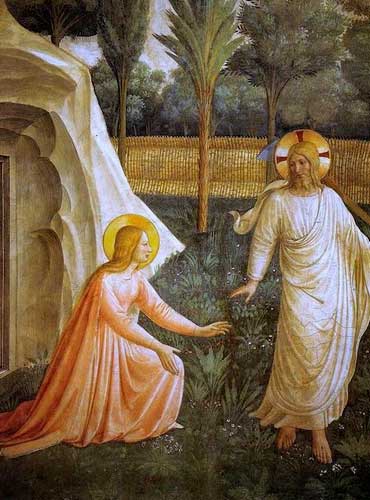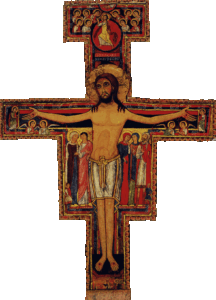Tuesday of the Octave of Easter – Jn 20:11-18
Today’s Gospel recounts for the appearance of Jesus to Mary Magdalene. Peter and John had come to the tomb, seen the burial clothes, and went back home. Mary, however, stayed behind, weeping. There are three things about Mary that are worth further meditation.
First, we can clearly see Mary’s great love for Jesus. Notice that Peter and John had come to the tomb, and just left. The Resurrected Jesus didn’t appear to them; nor did they see angels. Mary, on the other hand, is so consumed with love and so set on seeking out Christ that she thinks very little of speaking with the angels, since they aren’t the One whom she seeks. Even her short reply to Christ is full of love: Christ asks her, “Whom are you looking for?” and Mary replies, “Sir, if you carried him away, tell me where you laid him, and I will take him.” In her love and her sense of loss, she doesn’t even mention Jesus’ name. Likewise, she says “I will take him,” a very difficult, if not impossible, task; yet, her love is the sort that “banishes the hardest burdens, and think the heaviest burden light.”[1] We can ask ourselves: does our love for Christ keep us seeking Him, even in the midst of difficulties and challenges? Do we allow ourselves to be satisfied by mediocrity, or mere human pleasures and delights, instead of seeking only Christ, as Mary did? Are we willing to undertake great tasks for Christ because of our love for Him?
Second, consider the name Mary calls Jesus: “Rabbouni!” Jesus, as the Good Shepherd, calls all of His sheep by name, but Mary calls Him “My teacher,” or “My master.” It was a title of respect that would become the highest title of honor for a Rabbi.[2] We could think that she is almost asking for an explanation of how Christ is alive, how this miracle has come to pass. This was a miracle of a different order than the other resurrections she had seen, and she wanted to be taught about it. As for us, do we approach Christ the Teacher, asking to be taught by Him? Are we willing to learn lessons from Him, even if they come in the form of challenges and suffering?
Thirdly, we have Christ’s command to Mary: “Stop holding on to me.” Since the sentence is a command, we can infer that she probably grabbed Christ’s feet, which is only natural: after having lost Him, she wanted to hold on to Him. Although scholars offer different interpretations of why Christ says this, two of the most plausible seem to be that, first, she must let go because she has a task; she cannot stay worshipping Christ because she must go and announce the good news to the disciples. Second, and in a more spiritual sense, Christ means that Mary shouldn’t touch Him physically, so as to keep her faith. As one Church Father writes: “What can touching be, but believing? We touch Christ . . . by faith, and it is better not to touch Him with the hand and to touch Him with faith than to feel Him with the hand and not touch Him with faith. It was not a great matter to touch Christ; the Jews touched Him when they seized Him, they touched Him when they bound Him . . . they touched Him, and by touching Him in a bad way, they lost what they touched. Just you touch by faith, O Catholic Church.” For us, then, are we content to walk by faith, or do we seek constant signs and wonders in order to believe? With how much faith do we receive the Eucharist? How do we “touch” Jesus there? In this Easter season, let us ask, through the intercession of Mary, Cause of our Joy, for the grace to imitate Mary Magdalene in her love, her willingness to be taught, and her faith.
[1] The Finding of the Lost, by Venerable Fulton Sheen, 12 April 1936.
[2] HELPS Word-studies 4462 rhabboní (rabboní)





